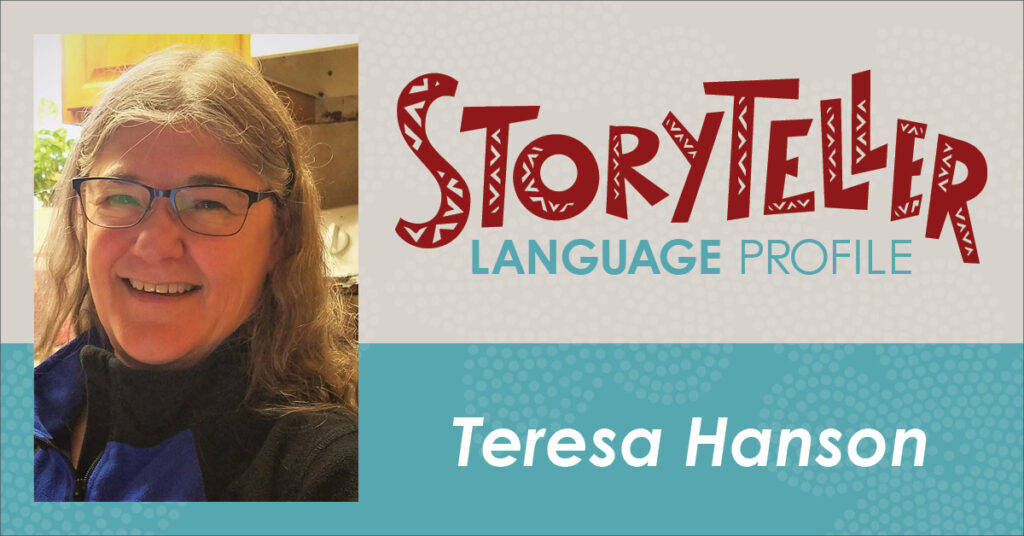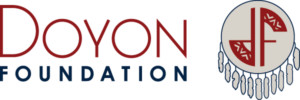
A language advocate whose dedication to the Dinak’i language shapes her professional life, Teresa Hanson began work in 2002 for the Village of Telida, where her grant writing has consistently secured funding for projects to document and teach Dinak’i.
Teresa was born in St. Louis, Missouri, grew up in Anchorage and lived in Juneau before moving to Fairbanks in 1984 where she eventually pursued a doctorate in the Dinak’i language at the University of Alaska Fairbanks (UAF). She lives near Fairbanks and holds a master’s degree in northern studies from UAF.
Spoken by Alaska Native people of the Upper Kuskokwim, Dinak’i is one of the languages that will be featured in Doyon Foundation’s Doyon Languages Online project, which offers online language-learning lessons for free to all interested learners.
Doyon Foundation: Your efforts over the past 20 years with the Village of Telida on behalf of the Dinak’i language are a real inspiration, especially because they permit you to work with families, Elders and linguists.
Teresa Hanson: I’ve literally worn most of the hats that working for a small Tribe entails, and that includes grant writing. Beginning in 2008, a language grant through the Administration for Native Americans ended up funding the Tribe’s language work for six years.
We found everything that was written in the language, mostly storybooks, and digitized them. We created a website that became ukpreservation.net and began to populate it. We received permission to use and translate into Dinak’i the lesson templates developed by the Yukon Native Language Center. And then we recorded those lessons plus all the storybooks that we digitized.
DF: Dinak’i lessons on your site help people learn sentences on topics that would come up naturally throughout the seasons of the year. What came next?
TH: We worked with Ray Collins, the linguist credited with writing down the Dinak’i language, and Gary Holton, a linguistics professor affiliated with UAF’s Alaska Native Language Center, to update and digitize the Dinak’i Junior Dictionary. We followed up by translating Gary’s phrase book into Dinak’i and then recording and digitizing it. And as we were doing all these things, we kept adding them to the website.
DF: You’ve said that one of the things you learned while working with the language was that documenting Dinak’i was urgent. Maybe you’ll say more about that.
TH: While I was taking classes, working towards a PhD., I found a very thick document that had each letter of the Dinak’i alphabet with word examples with the letter in the initial, medial and final positions in the words. Finding that document is one example of urgent work that needed to be done.
I was told by my instructor that the document was called a keyword list. As I looked through it, I could see that it was rich with references on the culture and subsistence hunting and gathering. There were 800 words, including many that weren’t in the Dinak’i Junior Dictionary that already existed!
This keyword list became my focus for the next couple of years. Steven Nikolai, Sr. wrote out 800 sentences using each of the words. This was amazing! We then recorded each of the words on that list — we call it phonics — and voiced them with a male, female and child speaker.
The Doyon Foundation language grants were instrumental in securing recordings from the phonics list and in turning the 800 sentences into lessons where you don’t have to know the language to begin learning it.
DF: And your work with Doyon Foundation on language documentation continued from there?
TH: That’s where I was when Doyon Foundation approached me for the Conversational Dinak’i (Upper Kuskokwim) course for Doyon Languages Online. To translate the lessons, I worked with Steven Nikolai, Sr. to record them and I worked with families in Nikolai and Telida. Oline and Stephanie Petruska went above and beyond and developed three more units!
DF: How about another example of language work that was accomplished?
TH: This one was in a whole other realm of language work. About eight years ago, I was in Nikolai where a new superintendent for Denali National Park and Preserve was being introduced. From time immemorial, the people of the Dinak’i language group have conducted subsistence hunting and gathering on land that has been designated as the park and preserve.
Two years earlier, the Village of Telida had secured a National Park Service grant to document Dinak’i place names. Other grants also were supporting this project. When Denali Park personnel heard that we doing a place-name project, they offered to continue funding it! I’m working on that project to this day. As a map nerd, I love the Place Name Project.
DF: How did your contributions on behalf of the Dinak’i language come to be? How did you become immersed in projects so important to the people of Telida?
TH: I originally began because I was an employee of the Village of Telida and this work needed to be done. It didn’t take any time to fall in love with it! I love languages and Dinak’i needed to be focused on.
It’s unusual to be a white woman who’s so involved in the Tribe and with its projects, and I’ve learned that there’s a name for someone like me: Language advocate. I felt like I was born for this purpose.
DF: What are some insights you’ve gained about the urgency of language learning?
TH: For me there was a long period of time building trust, especially to engage speakers to record their audio and video. I think this situation may be pretty common. If it happens to you, don’t push. Just be yourself. People who might have been reluctant at first are now my extended family.
And don’t give up even though many priceless knowledge-holders and speakers are passing on. So heartbreaking! I’ve learned to use time wisely, to do as much as you can so that even if eventually there are not more fluent speakers, there’ll be enough evidence left behind so that someone who wants to learn, can.
We are pleased to highlight the efforts of individuals committed to the revitalization of our Native languages. If you would like to nominate an individual for our Storyteller language profile series, please contact haytona@doyon.com or 907.459.2048.
